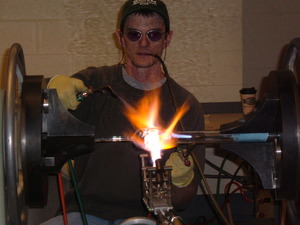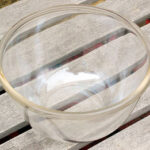I am a scientific glassblower. What is scientific glassblowing? Well, I’m writing because everyone I’ve met inevitably asks me that very question, with the exception of other glassblowers.
Scientific glassblowing is the craft of fabricating scientific apparatus from hollow glass tubing and solid glass rod. Borosilicate (Pyrex) glass is the preferred medium for scientific applications. The glass is manipulated by introducing heat from a torch. When the glass reaches its softening point, 785 C for borosilicate glass, the glassblower manipulates the glass by hand and introduces pressure (blows) to create the desired form. These techniques will be explained later in more detail. First, we will examine the place and function of scientific glassblowers in today’s society.
Scientific glassblowers work in a variety of settings. Many pharmaceutical companies and research laboratories employ scientific glassblowers to fabricate the glassware scientists need to conduct their experiments and research. Likewise scientific glassblowers can repair broken pieces, saving the company valuable time and money. These glassblowers are essential to the research & development departments of their companies for enabling experiments that require glassware that is not commercially available. Often times the scientific glassblower will suggest what type of apparatus the scientist needs based on descriptions of the experiment at hand. In this case, the scientific glassblower must have a good understanding of chemistry, laboratory procedure, and practicality of the use of glass in the experiment. Here, the scientific glassblower not only fabricates the apparatus, but designs it as well.
Universities are another place to find scientific glassblowers. Most major universities employ one or more scientific glassblowers to make and repair stock glassware for various science departments and coordinate research projects with students and faculty needing custom glassware. Research and university scientific glassblowers often act as the right hand of chemists and physicists and are the unsung heroes of many scientific advancements and discoveries. Would Edison have been able to design the light bulb without glass and someone to form it?
The last, and probably largest environment where one may find scientific glassblowers is the manufacturing industry. Located in Southern New Jersey, the city of Vineland is the heart of the world’s scientific glass production. While this work environment is not unlike any other factory setting, it is a means for those with a degree or aptitude in scientific glass to ply their trade. Unlike research or university scientific glassblowers, manufacturers have little say in regards to the design of the product. They work from blueprints, often doing “runs” of hundreds or thousands pieces of the same product. Also, scientific glassblowers work from home, collecting contract work from manufacturers and labs with which they’ve developed a report, but this sort of work is often a supplement to the scientific glassblower’s day job.
While simple glassware such as test tubes and vials are, today, automated in their manufacture, typical items the skilled craftsman fabricates include condensers, distillation units, multi-neck flasks, reactor vessels, and extraction systems.
We’ve established what scientific glassblowers do and where they do it. Now, let’s explore how they do it. Generally, there are two primary means of working with glass tubing. The first is known as lampworking. The term lampwork comes from the days when oil lamps were used to heat the glass. Foot operated bellows introduced air to the flame, making it hot enough to soften the glass. Today, lampwork is performed using a bench-mounted brass torch, still referred to as a lamp, that typically burns oxygen and propane. The high-end glassblowing torches allow the scientific glassblower to generate heat in various forms. Roaring, foot-long, bushy flames large enough to engulf the diameter of a tube, 60mm around, may be generated from the same torch capable of generating a hissing, pinpoint, blue flame used to introduce intense heat to a specific area of the glass. The lamp is the scientific glassblower’s paintbrush, and he will use numerous configurations of settings to create the desired flame for the particular task. It is important to note that nearly all lampwork requires a constant rotation of the glass tube in the flame. This is done by hand. If the tube is not rotated, gravity will pull the softened glass down and shape will be lost. The lampworker uses both hands to rotate the glass. This skill takes a long time to develop. The slightest deviation in one hand’s movement from the other will cause the glass to fold, thin out, or otherwise lose its desired form. The lampworker uses a variety of hand tools to shape the glass. These tools are mostly graphite in composition. Examples of graphite hand tools are reamers for flaring open ends of tubing or widening holes in the sides tubing and paddles used to flatten a tubes molten end. Other tools include tweezers, picks, and measuring devices such as calipers. Another important tool in the lampworker’s arsenal is the blow hose assembly. This vital set of materials is needed to introduce air into the tubing for means of proper forming. While it is possible for the lampworker to blow directly into the tube, the blow hose assembly allows the lampworker to hold his work at any angle and view the effect of his blowing as he works. The blow hose assembly consists of a rubber or cork stopper to make an air-tight plug in the tubing’s end, a brass swivel to facilitate rotation of the tube, and a latex hose that runs from the swivel to the lampworkers mouth.
Lathe work is another, and possibly more popular, means of working glass tubing. A glass lathe, like a wood late, holds both ends of the tubing and rotates at a constant rate. Remember, rotation of the glass is vital to avoid sagging. A blow hose assembly is attached to the tubing. Instead of a bench mounted lamp the lathe worker introduces flame with either a hand held torch, much like a welder’s torch, or a carriage burner. A carriage burner is a torch mounded on the bed of the lathe, below the glass and can be moved along the length of the glass. Foot pedals often operate these burners. Lathes are used for a number of reasons. First, if the glass is too large to be rotated by hand, the scientific glassblower must use a lathe to hold the glass. Another reason for lathe use is speed. Simple tasks, which could be done by a lampworker, are sometimes executed more quickly with a lathe. Likewise a lathe worker can work the glass without possessing the hand skills of a lampworker. While most scientific glassblowers will have both lamps and lathes in their workshops, lathes dominate the manufacturing industry for their ease of use by under skilled labor. The hand tools a lathe worker uses are similar to those of a lampworker, only larger in the case of working large pieces of glass. A well-rounded scientific glassblower will be skilled in both lamp and lathe work, and most individual pieces of apparatus are created using lamp and lathe.
Other skills of the scientific glassblower include cutting, grinding, polishing, sandblasting, and annealing glass. The cutting and grinding of glass is performed with saws and grinders that have diamond embedded in their surface. Other than their diamond composition, these tools are identical to table saws and belt grinders used in other types of workshops. Polishing is done either on an abrasive diamond wheel or with hydrofluoric acid. A cut edge of glass is very rough. Hydrofluoric acid, when introduced to the edge needing polishing, clears away the glass burs. Applying a soft flame to the rough edge, melting the surface into a uniform texture, can also clean rough edges. This is known as fire polishing. Acids may also be used to etch designs into the glass surface, though a more common means of doing this is by sandblasting. Sandblasting uses compressed air to blast abrasive grit onto the glass and scar designs onto the surface.
Annealing is usually the final step and is vital to the scientific glassblowing process. Heat creates stress in the glass. This happens because molecules of glass move when softened. As they move, they lose their original orientation to the other molecules of glass. When this softened glass quickly cools, the molecules have no time to reposition themselves into their original orientation. This causes stress in the glass, and if left in the piece, will eventually cause breakage. To remove stress the scientific glassblower uses an annealing oven. The entire glass piece is placed in the oven. The oven then slowly climbs to the annealing temperature of 560 C. This temperature is held while the molecules reposition themselves, and the entire piece is gradually and evenly brought back to room temperature. A device called a polariscope uses polarized light to detect any remaining stress in the glass. This is by no means an exhaustive listing of the scientific glassblower’s tasks.
Scientific glassblowing is becoming a rare trade. The craft is very difficult to master and many research glassblowing is being outsourced to manufacturing companies. Plastics are also replacing glass in many areas of industry. As for formal training, there is only one college in the U.S. that offers a degree in scientific glass technology. Salem Community College, located in Carney’s Point, NJ, has been teaching the craft of scientific glassblowing since the fifties. The program is an applied science degree and includes education in the humanities, science, and mathematics. Graduates of this program have gone on to work for institutions such as Dupont, Yale University, and NASA.
Scientific glassblowing is a fascinating profession. Who wouldn’t get excited when placing fragile glass into hot flames and watching a complex piece of apparatus form? Unfortunately, too many people have no idea this trade even exists. To keep this time-honored profession alive, both education and interest need to be fostered amongst the populace.







